Open Wide!
Dr. Peter Emily, Exotic Animal Dentistry
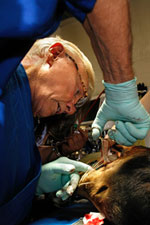 Dr. Peter Emily is a human dentist AND a wild animal dentist. One day you'll find him putting a crown in a person's mouth, and the next he might be doing a root canal on a polar bear. What happens when the anesthesia wore off one of his four-legged patients?
Dr. Peter Emily is a human dentist AND a wild animal dentist. One day you'll find him putting a crown in a person's mouth, and the next he might be doing a root canal on a polar bear. What happens when the anesthesia wore off one of his four-legged patients?
Dr. Emily says he will work on anything that has a mouth, including people, dogs, cats, birds, reptiles, rhinos, hippos - he's worked on them all!
So what kind of dental work can a snake need? Dr. Emily has mainly worked on setting broken jaws, which are usually the result of trauma.
Dr. Emily always has his instruments ready to go on a moment's notice, as he travels all over the world, including Brazil and Africa. He recently did dental work on 60 Cheetahs that were kept in a large sanctuary. The cheetahs were rounded up randomly and only 5 or 6 were re-released that didn't have dental issues. He has also done over 100 root canals in the jungle.
He's also worked on a dozen jaguars in sanctuaries in South America and on bush dogs. Bush dogs are a very dangerous species and they have different numbers of teeth than most carnivores. They are squatty looking animals, sort of like Corgis, but they are really not dogs, as we know them. Unfortunately, there are not many of these animals left.
Dr. Emily mentions going to a zoo on the east coast and working on polar bears who needed a root canal. You need to do everything that needs to be done at one time so that there will not be any further problems, and so that the animal doesn't have to be re-anesthetized. Dr. Emily was just preparing to sew up the surgical site and the polar bear started to wake up. The anesthesiologist said he was having a hard time keeping the bear down and that Dr. Emily need to go now! They put the bear on the cart and started wheeling him back to his enclosure, while Dr. Emily was riding on top of the bear suturing him up!
Fortunately animal's teeth are spread out more than in humans. We need to floss to get between tight spaces, but nothing gets stuck between their teeth.
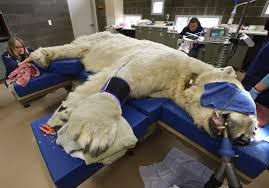 Dr. Emily also runs his own foundation called the Peter Emily International Veterinary Dentalß Foundation (PEIVDF). His organization takes care of dental disease in animals in shelters and sanctuaries all over the world, pro bono.
Dr. Emily also runs his own foundation called the Peter Emily International Veterinary Dentalß Foundation (PEIVDF). His organization takes care of dental disease in animals in shelters and sanctuaries all over the world, pro bono.
In the United States alone, there are about 20,00 to 30,000 wild animals, at 1,000 different shelters and sanctuaries. These are not zoo animals, but whatever animals you can find in a zoo, you can find in a sanctuary.
Dr. Emily works with a team to help him treat the animals, as he can't do it alone. He uses a lot of interns at the College of Veterinary Medicine; so they can learn how to work on animals other than cats and dogs. And if they're good enough, Dr. Emily will send them out to a sanctuary by themselves. Basically, a teacher becomes a teacher becomes a teacher!
Although semi-retired, Dr. Emily continues to work with the Denver Zoo, Deer Creek Animal Hospital and often on any interesting case that is put in front of this ever- curious innovator and lover of animals. When not working in the mouths of people and animals, Dr. Emily serves as the Dental Consultant and Conformation Judge for the American Kennel Club.
Dr. Emily mentioned doing a book about on all his wild adventures, as nothing like this has been done before, and he has been doing it about 45 years.
APPLY TO ATTEND UPCOMING MISSIONS: Exotic Feline Rescue Center - APRIL 5-6, 2014. PEIVDF will be returning to the Exotic Feline Rescue Center on the weekend of April 5-6, 2014. The patient census is still being developed, and so number of Tuition for Mission students is as yet unknown.
http://peteremilyfoundation.org
Demanding Pet With 8 Legs & Personality
Nancy King
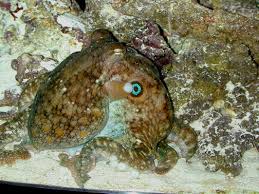 Nancy King hadn't always dreamed of having a pet octopus as she grew up, but when her husband presented her with a stuffed, plush octopus, she decided to learn more about them.
Nancy King hadn't always dreamed of having a pet octopus as she grew up, but when her husband presented her with a stuffed, plush octopus, she decided to learn more about them.
After going to The Octopus News Magazine Online (TONMO), Nancy decided she wanted to keep one. She knew it would be difficult, as she had no saltwater experience.
Once she got started, it took her over six months to set up a tank. She was then able to go online and buy an octopus over the Internet and have it shipped to her.
When Nancy got her pet octopus, Ollie, she made a serious commitment: She wouldn't spend a night away from her home in Dallas the entire time she had it. She knew octopuses didn't have a long lifespan, maybe six months to a year, and wanted to be there for Ollie.
So do octopuses make good pets and do they interact with you? Nancy says they do if you get a good one. Just like our dogs and cats, they all have different personalities. But if you get a good one, they will actually watch you and make eye contact with you. So they're watching you and you're watching them.
Nancy started out by putting shrimp on the end of a feeding stick, which helps them get used to you feeding them. Unfortunately you can't just run out and get octopus chow! They mostly like crabs and shrimp, which can get very expensive.
Ollie also demonstrated an ability to manipulate both objects and people by inventing a game. Ollie made use of a glass-cleaning tool with two pieces held together by a magnet, one inside the tank and one outside. Ollie would pull it off the inside magnet, creating the outside magnet to fall and make a loud "clunk." Nancy or her husband would come running to see what happened and Ollie would retreat in her den and dangle the inside cleaning magnet out on one sucker. Nancy would reach into the tank to get it back, and Ollie would snatch it back inside her den. Ollie would do this over and over again. While Nancy said it was frustrating, she also though it was funny at the same time!
Nancy had heard about other Octopuses watching television but Ollie never seemed to be interested in it.
One thing you have to watch out for is the escape artist, as they can get out of a tank. You have to make sure you "octopus proof" your tank. An octopus can live out of water for a short period of time, maybe around 30 minutes, before they need to go back in the water.
Nancy learned many things along the way. She said if there were a next time, she would get a larger tank (her first one was 55 gallons) and she would have an emergency tank as a backup. You can use this extra tank for food as well as in an emergency if your octopus "inks."
Inking is a protective thing. If they were in the ocean and they wanted to escape from a predator, they would puff out a big ink cloud, which would confuse their predator and allow them to escape.
You can also only keep one octopus in a tank, because they'll eat any tank-mates, including other octopuses.
Octopuses breed at the end of their life and produce eggs. However, they can breed earlier and the female will save the sperm and use it when she wants to. But once the eggs have been produced, that signifies the end of her life.
Animal Radio® News with Stacey Cohen
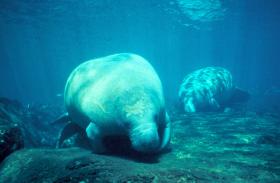 Old Video Causes New Problems
Old Video Causes New Problems
An old video posted online could cause new problems for two Florida men, one of which is seen jumping on top of a manatee and her calf. The video was first posted on Facebook about a year ago but now the Fish and Wildlife Conservation Commission is launching an investigation. Officers have already identified the men in the video and say they could face state and federal charges for harassing the endangered mammals.
Dogs Go Postal
Dogs go postal in Los Angeles more than any other U.S. city. The U.S. Postal Service released its rankings of the best and worst cities for dog attacks on mail carriers. Los Angeles recorded 69 incidents last year. San Antonio and Seattle round out the top three worst cities. Wichita, Kansas is the safety city with just 20 attacks. Dogs attacked almost 6,000 postal workers in 2012.
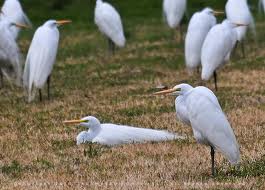 How To Scare Egrets
How To Scare Egrets
Residents in Fort Worth, Texas are gearing up to scare away egrets before they nest. Last year the egrets invaded neighborhoods, leaving behind droppings that filled the air with flies and turned some lawns brown. Because the Federal Migratory Bird Treaty Act of 1918 protects the egrets, the giant birds cannot be disturbed as they nest. This year, residents are taking preventative action and arming themselves with air horns and bells to scare off the giant birds if they fly around looking for places to build nests. Bill Campbell, who is president of the Tanglewood Neighborhood Association, tells the Fort Worth Star Telegram that people don't want the birds to get comfortable nesting in their neighborhoods, adding that residents will probably have to scare off the birds every year. In the future, some neighborhoods are looking into building areas where the egrets can nest in peace.
Bridge Construction Causes Deaths To Swallows
Wildlife protection group wants work on a freeway project in Petaluma, California stopped because it's causing the deaths of swallows that nest in the bridge structure. The Press Democrat says concern surrounds the construction at the Highway 101 bridges over the Petaluma River. The wildlife advocates say federally protected cliff swallows build mud nests in the bridge girders and Caltrans' efforts to keep the birds away is allegedly killing the birds instead. They are asking a federal judge to stop the work and force Caltrans to do additional environmental studies before resuming construction.
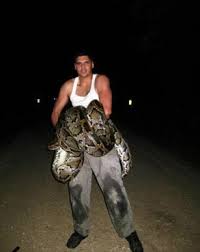 Record-Breaking Serpent Killed
Record-Breaking Serpent Killed
A man in Miami is responsible for capturing and killing the largest Burmese python ever recorded in Florida. According to the Florida Fish and Wildlife Conservation Commission, the record-breaking serpent was a 128-pound female that measured 18 feet and 8 inches in length, shattering the previous record of 17 feet and 7 inches. Apparently, Miami resident Jason Leon was driving in a rural area of Miami-Dade County when he and a passenger spotted the giant reptile in the roadside brush. Grabbing the snake by the head, Jason began pulling it out of the brush. That's when the python began wrapping itself around his leg. After getting help from his buddies, Leon killed the snake with a knife. Kristin Sommers, of the Florida Fish and Wildlife Conservation Commission, says the Commission is, "grateful" to Leon for "safely removing" the large snake and reporting it to authorities.
Dolphins Locate Rare 19th Century Torpedo
A rare 19th century torpedo is back in the Navy's hands thanks to the work of a few bottlenose dolphins. The Los Angeles Times reports Navy owned dolphins discovered a Howell torpedo while being trained to track down underwater objects off the California coast. Only one of the antique underwater weapons was known to exist prior to the discovery. The dolphins are trained to use their natural sonar to discover objects that not even billion dollar military technology can detect. The torpedo is bound for the Washington Naval Yard, where it will be cleaned and put on display.
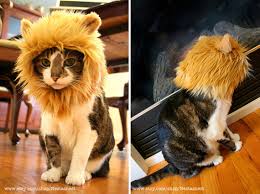 Hat Transforms A House Cat Into A Lion
Hat Transforms A House Cat Into A Lion
A designer in Seattle has come up with an easy way to transform an average house cat into the king of the jungle: the lion hat. Yumiko Landers tells Metro.co.uk that the idea for the feline headpiece came from her sewing group. While making something to fit the cats' and dogs' theme that week, Landers came up with the so-called hat that allows the cat to sport a lion's mane. The product even comes in multiple colors, including golden brown, black, grey, ivory and husky. Landers sells the hats online through Etsy, and says she never would have expected to be receiving orders from all over the world.
Dogs Good For Our Hearts
The American Heart Association (AHA) has declared that pets, especially dogs, are good for a person's heart. Further proof that dogs are among the best friends a person could have. Dr. Glenn N. Levine, Director of Baylor University's Cardiac Care Unit, was quoted in a press release from the AHA saying, "Pet ownership, particularly dog ownership, is probably associated with a decreased risk of heart disease." The AHA writes that owning a dog, "may help reduce cardiovascular risk," perhaps due to dogs bugging their owners into taking them for walks on a regular basis. Dog owners were, according to the AHA's studies, 54 percent more likely than non-dog owners to get the suggested amount of exercise. Good news, no doubt. But one shouldn't expect a dog to offset unhealthy lifestyle choices. "If someone adopts a pet, but still sits on the couch and smokes and eats whatever they want and doesn't control their blood pressure, that's not a prudent strategy to decrease their cardiovascular risk," Levine told the Times.

NEWS UPDATE brought to you by Drs. Foster & Smith, affordable pet supplies. Low prices every day, so you save on every order.
 Listen to the entire Podcast of this show (#744)
Listen to the entire Podcast of this show (#744)



 Dr. Peter Emily is a human dentist AND a wild animal dentist. One day you'll find him putting a crown in a person's mouth, and the next he might be doing a root canal on a polar bear. What happens when the anesthesia wore off one of his four-legged patients?
Dr. Peter Emily is a human dentist AND a wild animal dentist. One day you'll find him putting a crown in a person's mouth, and the next he might be doing a root canal on a polar bear. What happens when the anesthesia wore off one of his four-legged patients?  Dr. Emily also runs his own foundation called the Peter Emily International Veterinary Dentalß Foundation (PEIVDF). His organization takes care of dental disease in animals in shelters and sanctuaries all over the world, pro bono.
Dr. Emily also runs his own foundation called the Peter Emily International Veterinary Dentalß Foundation (PEIVDF). His organization takes care of dental disease in animals in shelters and sanctuaries all over the world, pro bono.  Nancy King hadn't always dreamed of having a pet octopus as she grew up, but when her husband presented her with a stuffed, plush octopus, she decided to learn more about them.
Nancy King hadn't always dreamed of having a pet octopus as she grew up, but when her husband presented her with a stuffed, plush octopus, she decided to learn more about them. Old Video Causes New Problems
Old Video Causes New Problems
 How To Scare Egrets
How To Scare Egrets
 Record-Breaking Serpent Killed
Record-Breaking Serpent Killed
 Hat Transforms A House Cat Into A Lion
Hat Transforms A House Cat Into A Lion
